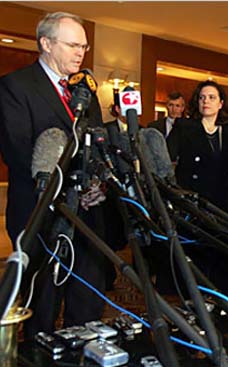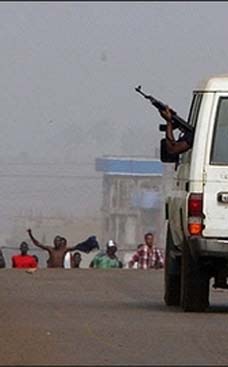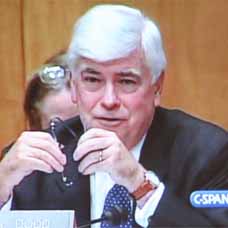
"There was an interesting men's group in Paso Canoas called 20/30," she says. "One day, the group came to me and asked what I thought about building a playground for a nearby kindergarten. I said, 'I would love to, but I've never built one before.' So they said, 'Why don't we just try.' " That was enough to enlist Christensen, and she was off to San Jose to research books on building playgrounds. "My first book was called Playgrounds for Free, and it showed you how to put together tires, telephone poles and aluminum pipes, among other things, to build a playground," she says. "When I returned, the men and I began designing funky pieces of play equipment. We built our first playground and it was so successful that another school wanted one, and another, and we ended up building six in different villages." The best part of building the playgrounds was that they became community projects, she says. Nearly all of the labor and materials were donated, with the most expensive playground costing $30. "The beauty of these projects was that the Costa Ricans found a need in their communities, and together we were able to fulfill that need," Christensen says. "They didn't wait for the government to help them, and the government didn't interfere with their projects."
Costa Rica RPCV Karla Christensen designs and rebuilds playgrounds
Child's Play
Donna Diermann Soper (N '87)
tulanian@tulane.edu
Caption: Bosnian children swarm Karla Christensen, center, at one of the playgrounds she designed in the war-torn country. Photography By Karla Christensen.
As the car left the city of Split, Croatia, and headed north along the coast of the Adriatic Sea, Karla Christensen began wondering if her far-flung impressions of the country once known as Yugoslavia were misguided.
The area was plush, with a beautiful landscape and Mediterranean climate, and her thoughts turned toward the exciting humanitarian aid project she had been hired to manage: rebuilding playgrounds for the children who were made victims of the war in Bosnia, which had ended two years earlier, in 1995.
Her fantasy of a Mediterranean paradise was short-lived, however, as the car released its hug on the coast and turned eastward toward the city of Sarajevo. Nothing--not even the frequent images that had flashed across her television screen in the United States--could have prepared her for the reality that was to unfold before her eyes.
"We got about a half-hour away from the coast in Croatia, and I looked around and I said, 'Why is every single home destroyed?' There was no one living there. It was completely deserted for tens of miles," Christensen says. "It was all rubble; all you saw was the foundations of the homes."
It was dark by the time the car arrived in Sarajevo, so it wasn't until the next morning that Christensen was able to witness firsthand the devastation in this once densely populated city.
"A friend of mine picked me up the next day and took me to the front line of Sarajevo, which was near the airport," she says. "Adjacent to the airport there were four- and five-story buildings that were gutted with grenade holes. What affected me most, though, were the ribbons that were wrapped around 80 percent of these apartment buildings. They said mina, which means "mines." Not only were these buildings destroyed, but mines were placed in what was left of them so that no one could return.
"After two years, I went back to that place and a lot of those buildings had been restored by international aid organizations," she says. "But that was my first impression of Bosnia. It was horrific."
Answering the Call
Tall and lean and sporting a few more curls than she had during college at Tulane, Christensen exudes a peacefulness and contentment that belie the physically and spiritually depressed area of the world from which she returned this past March. She speaks slowly and cautiously, sipping her coffee as she chooses just the right word to describe a particular experience or scene. There is an underlying pride in her voice as she reveals how a 34-year-old woman came to lead a project that ultimately built 250 playgrounds in Bosnia. But there's also a tension--one that is triggered by certain memories and gives the impression that even after a two-year stay, she continues to be shocked by what little the war left behind.
Her tale begins more than a decade ago when the U.S. Peace Corps opened her eyes to the world of play.
Within a year of her 1987 graduation from Newcomb, Christensen found herself the owner and operator of a small but thriving catering business in New York City. Despite the moxie and effort it took for a native Louisianan to successfully delve into the food business in a city that's not especially friendly to outsiders, Christensen says she was not happy. She felt a calling toward international work that had begun during her college years.
A sophomore transfer student from Emory University, Christensen says her first taste of life beyond U.S. borders occurred when she spent a summer in Ecuador working with cottage industries. "We visited the women there and assisted them in some of their projects."
Later, at Newcomb, she majored in international relations and took advantage of another international opportunity: participating in the Tulane-Newcomb Junior Year Abroad program in Florence, Italy. Though she was accepted into the master's program at Columbia University's School of International Affairs, Christensen says she decided not to go, and thus, the catering business.
"While the catering business was exciting, I knew that was not what I really wanted to do," she says. "I had already applied for the Peace Corps, so I just re-enacted my file. I was accepted and sent to Costa Rica from 1989 to '91, and that is where I started to build playgrounds."
Christensen was placed in a program called Women in Development and sent to a very remote town of 2,000 people called Paso Canoas, which sits on the border of Costa Rica and Panama.
"This was a very dangerous time to be in Central America because it was during the regime of Gen. Manuel Noriega in Panama," she says. "My Panamanian friends, who were part of the opposition, had their homes burned by Noriega's soldiers."
Despite the threat to her own safety as an American citizen, Christensen was undaunted in her mission and was soon called upon to assist in a project that would become her life's work for the next decade.
"There was an interesting men's group in Paso Canoas called 20/30," she says. "One day, the group came to me and asked what I thought about building a playground for a nearby kindergarten. I said, 'I would love to, but I've never built one before.' So they said, 'Why don't we just try.' "
That was enough to enlist Christensen, and she was off to San Jose to research books on building playgrounds. "My first book was called Playgrounds for Free, and it showed you how to put together tires, telephone poles and aluminum pipes, among other things, to build a playground," she says.
"When I returned, the men and I began designing funky pieces of play equipment. We built our first playground and it was so successful that another school wanted one, and another, and we ended up building six in different villages."
The best part of building the playgrounds was that they became community projects, she says. Nearly all of the labor and materials were donated, with the most expensive playground costing $30.
"The beauty of these projects was that the Costa Ricans found a need in their communities, and together we were able to fulfill that need," Christensen says. "They didn't wait for the government to help them, and the government didn't interfere with their projects."
New Directions
Having an integral role in such a rewarding project gave Christensen the opportunity to rethink, once again, where she would like her career to go, and she discovered that what she enjoyed most was the designing aspect of the playground projects.
While she was still in Costa Rica, a brief and fortuitous encounter with a World Bank architect prompted her to investigate pursuing a master's degree in landscape architecture, and by 1991, she was enrolled in Louisiana State University's three-year program.
Christensen started working on her thesis immediately: Building a Playground with the Participation of the Community. She was able to test the model she developed for her thesis in 1994, when a local Rotary Club and Kiwanis Club financed a trip for her to Venezuela.
"I went to a beautiful community called Maraicaibo, which had just bought a little island where they were planning to build a playground," Christensen says.
While her degree in landscape architecture provided her with more knowledge of construction techniques than she had had in Costa Rica, Christensen says she still had to learn how to be inventive with what few and interesting materials they had available. "The roof on the play equipment was actually made of palms," she says, "and the fencing was made of mangle, a small tree that grows in the water."
It took three months and $1,700 to build the playground. "I never slept," Christensen says. "I was on a high to be working with so many beautiful people who were so excited about the project."
The final reward, though, "was to see the kids playing on it. They were shouting and screaming on a playground that they actually helped to design themselves. I still get letters from the kids who play there."
Shortly after completing the project in Venezuela, Christensen received a Fulbright scholarship to the University of Malta. "I was there for nine months, working with geologists, botanists, architects and tourism department officials." Christensen was the landscape architect on the team that designed an eco-tourist park on the site of two Neolithic ruins.
In 1995, Christensen returned to the United States to attend a conference in Birmingham, Ala., sponsored by the International Association for the Child's Right to Play. Among the hundreds of playground experts participating in the conference was the owner of a company called White Hutchinson Leisure and Learning Group.
"The owner of the company, which was based in Kansas City, Mo., was looking for someone to help him design the outdoor play areas that accompanied his 'edutainment' centers," Christensen says. "The edutainment centers were fun centers like Discovery Zone, but he went a little bit farther by introducing water, sand and pretend play."
Christensen wasted no time in accepting the job and moving her belongings to Kansas City. "Together, we developed these children's play gardens in several states, including California and Oregon, and even Morocco."
After two years, however, Christensen says she started missing the non-segregated aspect of what she was doing before. "At the edutainment centers, parents had to pay $9 for their children to get in, so that excluded some children from being able to play there. I decided I wanted to go abroad again and work in a community that was really desperate for help."
The Returned Peace Corps Volunteer Conference in 1997 provided Christensen with the perfect opportunity to reconnect with former comrades and to seek out opportunities abroad. The conference, which was held in San Diego that year, is an annual gathering of those who have spent two years of their lives working in an economically developing part of the world. They come together to share their experiences as American volunteers and to learn about Peace Corps projects across the globe.
Christensen walked the length of the exhibit hall carrying her portfolio featuring photographs and sketches of the playgrounds she designed and helped to build in Costa Rica, Malta, Venezuela and the United States. Just as she was beginning to think that her craft--and her dream--was too specialized, she approached the last booth, where she encountered representatives from the American Refugee Committee (ARC), a non-profit, non-sectarian, humanitarian organization that works for the survival, health and well-being of refugees and displaced persons affected by war. ARC had just received a grant from USAID, which is a government organization, to build and repair playgrounds in war-torn Bosnia.
"The representative I spoke with couldn't believe the coincidence," Christensen says. "He told me they were looking for someone to be the program manager for the playground and sports field program funded by USAID. Two weeks later, I was offered the job and flew to Bosnia."
Though the Dayton Peace Accords, which ended the war in Bosnia, had been signed two years before Christensen arrived there, the war's legacy continued to inhibit the freedom, movement and redevelopment efforts of those who had remained and those who were just returning. As a result of the accords, the country was divided into two sides, the Federation of Bosnia and Herzegovina and the Republic of Serbia. The leaders of both sides were trying to encourage those who had fled from their cities to return to a place that no longer resembled their home.
"What really affected me was that I wasn't able to take walks in the forest because of the mines," Christensen says. "Now, you might think of this as an inconvenience for a foreigner. But what about the native children who just wanted to go out and run and play in the forest, or the children who couldn't go to the park where they used to play because it was covered with mines?
"Needless to say, none of the parks had trees because they were all cut down during the war," she continues. "There was no heat or electricity. There was no maintenance of any of the facilities. Everything was falling apart."
The main goal of the humanitarian aid organizations such as ARC was to help in the reconstruction of towns and villages so that the original residents would feel comfortable returning, Christensen says. "The first step was to replace the windows in all of the buildings. Once the buildings had windows, people felt they could come back to sell their goods. The next step included restoring homes, schools and health centers.
"USAID, however, thought that playgrounds should be part of this process so children would feel welcome to come back," Christensen says. "It was also to create a sense of normalcy. When you go to a city or village and you see children playing, you think, 'This is a normal life.' "
The playground project was separated into two phases. The first was a six-month contract to build 150 playgrounds. "When I heard this, I thought it was a joke," says Christensen, who had taken up residence in Tuzla, which is on the Federation side of the country. "The regional director showed me a map and the playground sites were all over Bosnia, with the furthermost one located four hours away from Sarajevo."
Fortunately, Christensen says nine staff members--including herself, six engineers, two community outreach officers--had already been assembled, so it wasn't long before the first playground was under way.
"We had three standard designs that we applied to the sites," she says, "We were able to finish the 150 playgrounds in the projected six months." USAID was so pleased with what its grant to ARC had accomplished that it asked ARC to write another proposal for a second phase, which was approved immediately.
"The second phase, which involved another 102 playgrounds, was more interesting because I was able to select the sites," says Christensen, who at that time relocated to Banjaluka, which is the capital of the Serbian Republic side of the country. "We chose beautiful sites in existing parks."
For the second phase, the staff increased to 16 and the contractors numbered 32. "The entire playground project served as a job-training experience for all the contractors and local staff involved," she says. "It helped to define their skills so that these individuals would become valuable workers when the humanitarian aid organizations left."
All told, ARC's playground caper in Bosnia cost $3.1 million. In addition to providing for the labor and supplies used to build the playgrounds, the money was used to buy toys for some elementary schools and to organize multi-ethnic bike races. "
Another goal of this project was to encourage contact between ethnic groups," Christensen says. "The bike races were a recreational way to help bridge this divide, and because the races were successful in this regard, they received recognition on the third anniversary of the Dayton Peace Accords in Ohio last year."
Christensen spent last summer in Costa Rica, traveling and searching for property to buy. In August, she went on an Alaskan vacation. And in September, she attended the Peace to Play Conference in Belfast, Ireland, where she presented a talk on her experiences in Bosnia. After that, she says, "Who knows?"
But whatever work she chooses to pursue next, one can be certain that it will involve play.
Donna Diermann Soper is a 1987 graduate of Newcomb and a frequent contributor to Tulanian. At press time, Karla Christensen was leaving for a new job with Save the Children in Kosovo.
This article originally appeared in the Fall-Winter 1999 issue of Tulanian magazine.
Tulanian
Fall-Winter, 1999
















